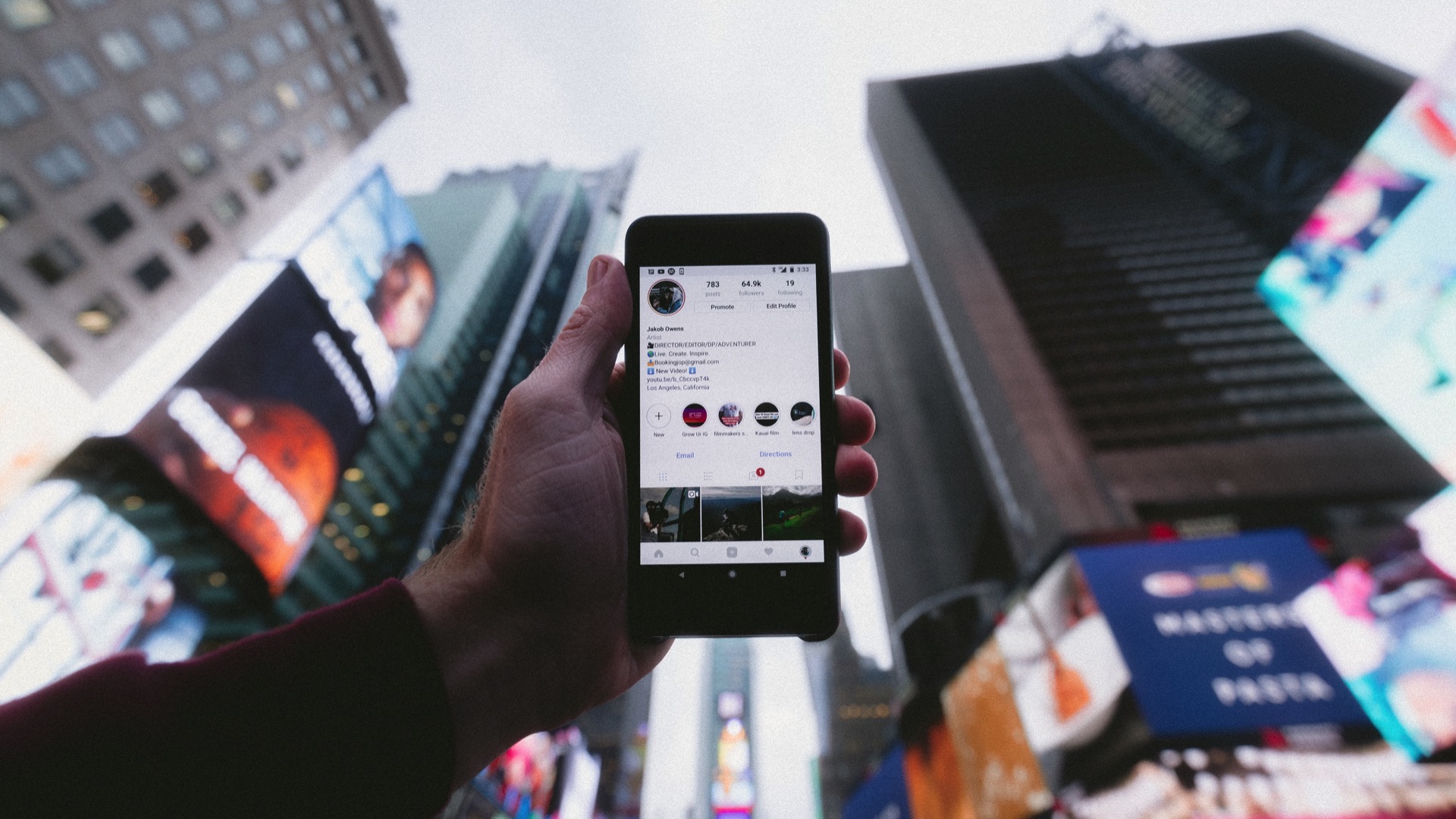The latest statistics from Instagram for business are mind-blowing.
200+ million Instagrammers visit at least one business profile daily, a third of the most-viewed stories come from businesses, and over 2 million advertisers worldwide use Instagram to share their stories and drive business results.
That’s massive!
The numbers speak loudly about how this platform has evolved and how B2B businesses can leverage it in the future.
The bottom line: If you’re a B2B business, it pays to be on Instagram.
But here’s the thing:
The platform keeps changing—for example, by no longer displaying content chronologically but instead based on an algorithm, à la Facebook. Some changes work for marketers; others don’t. The result: Keeping your audience engaged remains a constant challenge.
There’s another big reason that B2B businesses have trouble generating engagement on Instagram.
With 25+ million business profiles, there is major content overload. In fact, users don’t see 70% of the posts in their feed, even though Instagram is the social media platform with the highest engagement levels!
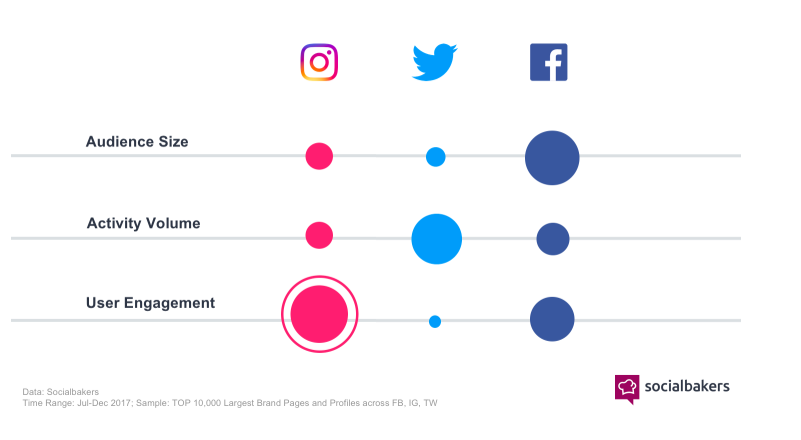
The truth is, if you don’t invest in boosting your engagement, your audience probably won’t find you.
So how do you ensure that you get in front of potential customers?
You need to get creative—not only do you need the right content ideas, but also a clear understanding of the tools that can grow your Instagram presence. If you are a B2B marketer who’s decided to harness the popularity of Instagram, this post will empower you with 27 content ideas and 16 great tools to help your profile become a success.
How to start planning your B2B Instagram presence
A lot of B2B marketers approach Instagram without a strategy, so it should come as no surprise when their efforts don’t translate into value for the brand.
If you want to leverage Instagram for your B2B business, you need to know exactly who your audience is, the goals you want to achieve, and the voice and tone that are appropriate for your brand.
Let’s talk about each of these important steps:
#1: Identify Your Audience
Who’s your audience?
This can be a tricky question to answer, but it’s imperative for finding success on Instagram.
Pew Research Center points out that Instagram skews heavily toward a younger demographic with varying levels of education and income.
This research provides a broad picture of the people on the platform, but by pairing it with your own data, you can nail down your real audience and create content (images and videos) that actually resonates with them.
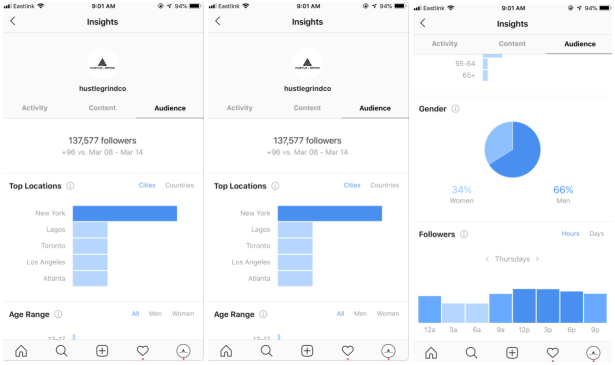
Instagram has a native analytics tool that can reveal a lot about your audience, but if you’re just starting out, glean what you can from other analytics tools you already use, like Facebook Audience Insights—your Instagram audience may not mirror your Facebook followers, but the data will at least give you a starting point.
#2: Set Goals
A successful Instagram strategy is guided by one or more specific goals.
What are you after—brand awareness, more clicks, comments or shares or visits to your pricing page?
Setting goals from the very start ensures that you proceed with clear direction and that all your content is designed to further those goals.
#3: Define Your Voice & Tone
Tone and voice matter a lot in B2B marketing—perhaps more than we realize.
And did you know that tone and voice are two different things? Buffer’s Kevan Lee defines them like this: “Essentially, there is one voice for your brand and many tones that refine that voice. Voice is a mission statement. The tone is the application of that mission.”
A consistent voice across channels ensures that your brand maintains a unified image. Your audience will come to “recognize” your voice.
But your tone can and should change to fit the platform or the content you’re posting—for example, a customer service comment on Facebook vs. a motivational video on Instagram.
The challenge is that many B2B businesses don’t know where to begin!
Kevan Lee offers this graphic from Stephanie Schwab, who includes tone as one of four key components of a brand’s voice:
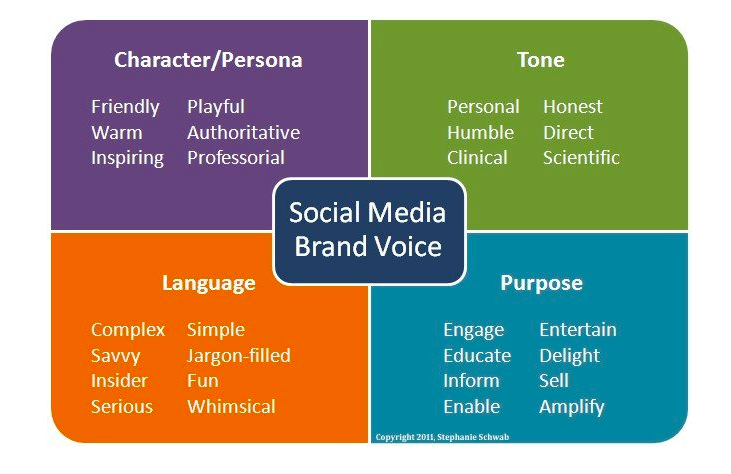
To refine your overall voice, define each of the four areas: What kind of person does your brand sound like? What’s the vibe? What kind of words do you use? What are you trying to accomplish?
Mailchimp has a great resource to help you understand this concept. The company’s voice and tone guide is considered the benchmark in the B2B tech SaaS space because of its specificity and well-defined framework.
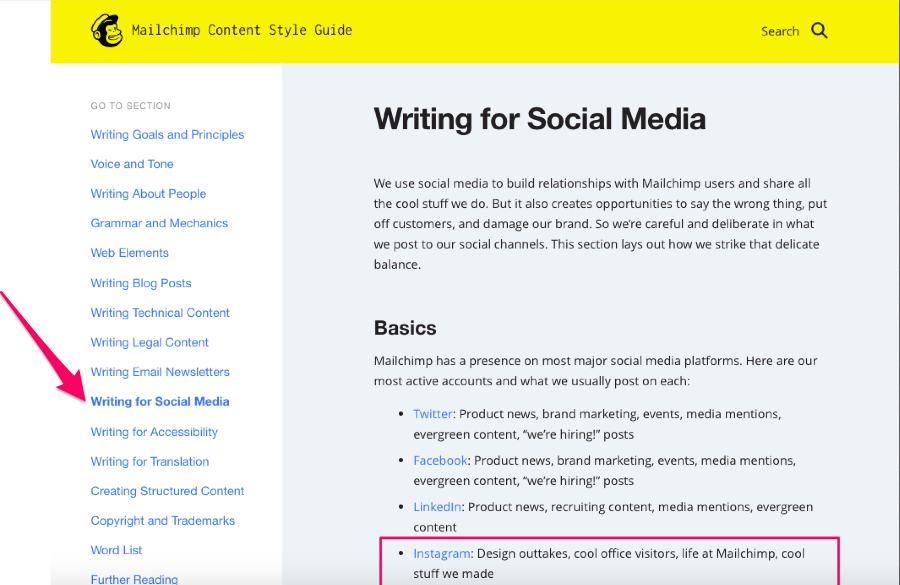
Now that you know the basics of a successful Instagram strategy, let’s move on to those 27 content ideas for your Instagram feed.
What To Share On Instagram: 27 Ideas To Get You Started
The biggest problem that B2B marketers face with Instagram is generating creative, engaging content.
Businesses that share poor content see low engagement numbers. After all, would you like or share lackluster content?
Of course not.
But you don’t have to reinvent the wheel in order to publish good content. Pick from the list of proven content ideas below and adapt them for your business.
1. Product images
As an image-driven platform, Instagram is the perfect place to share images of your product. Posts like these boost product awareness, especially when accompanied by hashtags and branded hashtags.
2. New product & feature announcements
Your team is working hard to roll out a new product or a new set of features. Worth a mention on Instagram? Definitely.
3. Behind the scenes
People always want to peek behind the curtain. Behind-the-scenes content humanizes your brand and builds trust with customers and prospects—plus, it shows off your company culture to prospective talent.
4. Real employees
Ever looked at a brand and wondered about the people who work there? It’s a thought that always crosses my mind, and I know I’m not alone. Just like me, there are others (read: prospects) who are keen to see the real faces behind your brand—the people they will interact with when closing a deal. So show off your team!
5. Company values
Whether your brand stands for diversity, inclusion, community or something else, Instagram is a great platform to showcase your values.
6. Blog posts & case studies
It’s true that B2B landscape has changed drastically.
The average B2B decision-maker isn’t a 50-something, but a 30- or 20-something.
These buyers are extremely savvy; in order to get their attention, you have to be where they are (like Instagram) and share content that pushes them to your product.
Blog posts and case studies fit the bill perfectly.
7. Podcasts
Drift uses Instagram to share snippets of their podcast. Buffer, on the other hand, has a highlight section dedicated to their podcast.
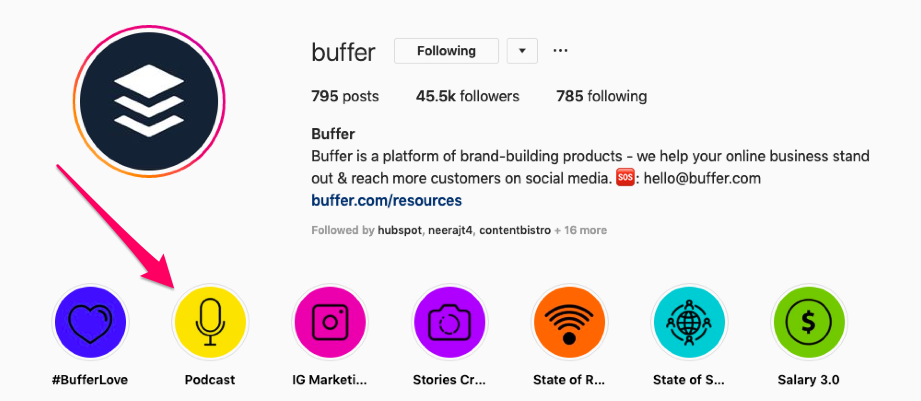
Your brand can do the same—you can use Instagram either as a content distribution channel, like Drift does, or to promote someone else’s work that can help your customers.
8. Webinars
The consumption of video content (webinars included!) is at an all-time high. Using Instagram to share content like this—be it a teaser, a snippet or even a full-length webinar created specifically for IGTV—can be a good distribution strategy.
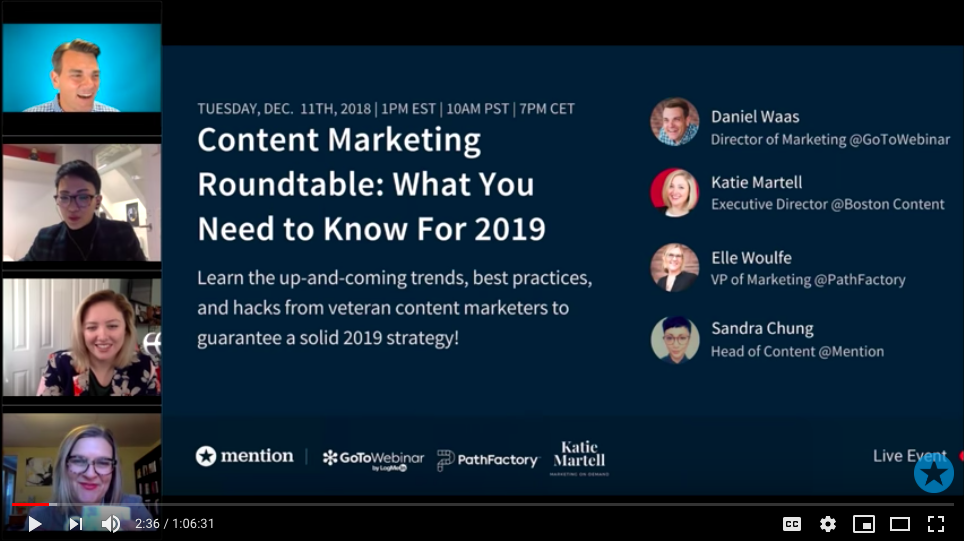
9. Content from partners
If you see something that matches your values on a partner’s Instagram feed, regram it for your followers.
10. Historical images
Found something exciting or funny in the archives? Share it on Instagram. Here’s an example from Novartis:
You can also leverage popular hashtags like #throwbackthursday and #flashbackfriday to make these posts more visible.
11. Contests & giveaways
Want to boost engagement quickly? Host a contest or giveaway. Unsurprisingly, these are pretty popular and can lead to a deluge of new followers. If you are looking for ideas, this post can help you get started.
12. Company milestones
Build your credibility by sharing company milestones. A milestone could be anything—launching a new office, reaching a certain number of employees… Let your customers celebrate with you!
13. Quotes & videos from your team
Got something significant to say? Share words of wisdom, tips and motivational quotes from your core team. Sharing your expertise offers value to your audience while increasing your authority. And, as I said before, customers like to get to know the people behind the brand.
14. Event highlights
When you attend an industry event, take your followers along for the ride by sharing live videos and images.
15. Thought leadership
Like quotes and tips from your team members, any content that displays expertise is valuable to both you and your customers.
16. Product tips & advice
Most brands already produce this kind of content, but it’s usually long-form.
However, with a little creativity, this info can be broken down into smaller, visually appealing chunks—think checklists, or even carousel posts that offer step-by-step instructions or highlight several product features.
This tactic not only provides an awesome content repurposing opportunity, but it also helps brands push traffic to their website for more tips.
17. Industry stats
Sharing the latest statistics and research from your industry keeps your followers informed about how your industry is growing, what changes that they can expect and how they can reap the benefits.
18. New clients
When you land a new client, share the news with your followers. This is one way to harness the power of social proof and make your new clients feel appreciated.
19. Corporate social responsibility
Is your brand contributing to CSR initiatives? If so, let your followers know what you’re up to. Here’s a good example from Pfizer:
20. Latest innovations
Got an idea that’s going to shake up the industry? Share it with your audience. The trick is to not give away too much information, while still letting your followers know that something interesting is brewing. Here’s a good example from Freshworks:
21. Clips from company events
Use Instagram to share pictures, videos and other important takeaways from your latest company event, be it a seminar, an industry event, or even your recent company retreat!
22. Compelling stories
Create brand stories in blog format or even as short videos you can post directly to Instagram.Sprout Social used the hashtag #notwodays to share a day in the life of various marketers (who happened to be customers of theirs):

23. Video tutorials
If you haven’t already invested in video as a marketing tool, Instagram provides an amazing platform for different kinds of videos.
Experiment with product tutorials—short videos can be shared as regular posts, while longer videos can live on IGTV.
24. Branded gear
Showing off branded gear (or a plush version of your mascot) is great for brand awareness and engagement. Here’s a good example from Hootsuite, which uses Instagram to show off their branded merchandise using the hashtag #hootswag:
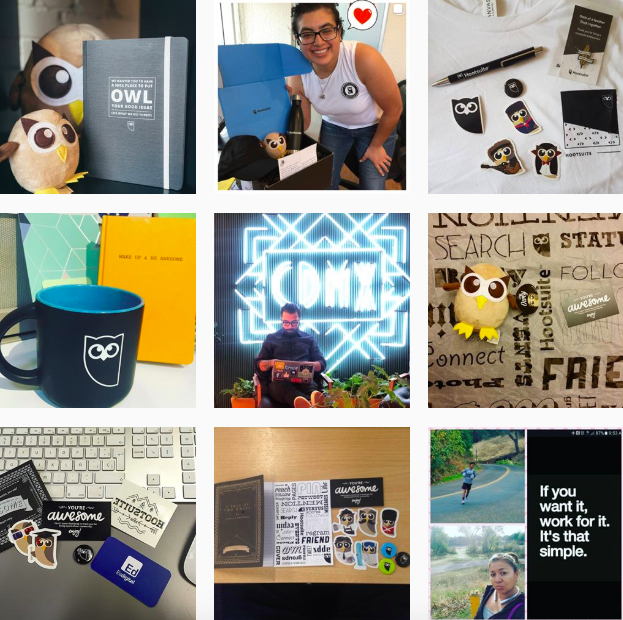
25. Partnered content
Collaborate with influencers to create content that’s relevant to both your audiences. B2B influencer marketing is a real opportunity to increase the visibility of your content and attract more followers.
Ross Simmonds, digital strategist with Foundation, shares how to leverage influencer marketing in the B2B realm:
26. Instagram Stories
Instagram Stories are short-lived posts that can be used in multiple ways to connect with your audience and boost engagement—use Stories to run polls, conduct AMAs, share live videos and add links.
27. IGTV
Instagram is all for vertical videos, and that’s why it launched IGTV. Although you can share videos in a regular post, IGTV videos are longer and therefore offer expanded opportunities to share exclusive content, repurpose old content and do a lot more.
Making it all work: the right tools to elevate your Instagram feed
Now that you’ve got a list of great content ideas, you can start putting together an engaging Instagram profile.
At this stage, you’ll encounter three major challenges. Let’s examine each one and look at the tools you can use to fix it.
Challenge #1: Ensuring that your feed is bright
Instagram is a visual medium, so followers expect to see content that’s a treat for the eyes. Your content won’t attract any shares, likes or comments if the images and videos are low-quality, poorly cropped or bland.
Don’t panic if you’re not a professional photographer. With the right editing tools, you can make your images appropriately bright and shiny.
Here are a few I recommend:
- VSCO is by far the most-used photo editing tool. It comes with presets and helps you fix contrast, saturation and graininess.
- BeFunky is a web-based photo editing tool that allows you to crop, resize and improve your images.
- Enlight comes with a ton of features that will help you amp up your feed, from basic lighting and color adjustments to artistic filters, graphic elements and more. Available only on iOS.
- Video Editor enables you to crop videos and add cool effects like slo-mo and reverse. Available only on iOS.
Adobe Photoshop Express is yet another tool that’s been well-received.
For those looking to explore more options, check out our article on free Adobe Photoshop alternatives.
Challenge #2: Ensuring that your content is well-planned
Businesses that post frequently see a higher engagement rate than businesses that post less often. According to research by Tailwind, the more posts you publish, the more likes you get. Posting frequently also nets you more followers.
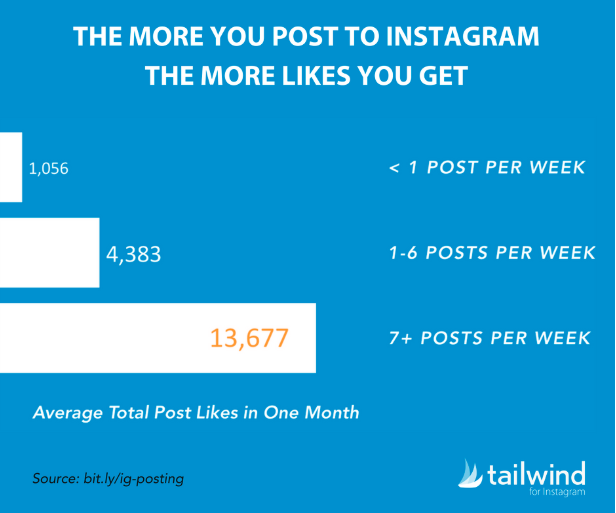
That being said, you shouldn’t post on a whim, or frantically look for ways to fill your daily posting quota. You need to plan ahead.
These tools can give you a bird’s-eye view of your content and your shipping schedule:
- Later lets you visually plan and schedule your Instagram posts, and it has a tool to add multiple links to your posts and profile.
- Sprout Social is a multi-platform tool for scheduling your content. Comes with a built-in image editor to add filters and overly text.
- Tailwind has a drag-and-drop calendar for scheduling and allows you to upload images in bulk.
- Sked Social automatically posts evergreen content that you’ve preloaded, and its calendar comes pre-filled with holidays like National Donut Day.
Buffer, Hootsuite and Zoho Social are a few other tools that can come in handy for scheduling content.
Challenge #3: Ensuring that your efforts are working
Beautiful feed? Check.
An amazing content plan? Check.
But how do you know what’s working and what’s not? How can you take your Insta game to the next level?
Enter analytics tools for Instagram. Here are five that can give you the insights you need:
- Socialbakers is known for its powerful analytics, but it also comes with a built-in persona creator to help you craft content that matters to your audience. Some tools are free.
- Iconosquare is a paid tool that provides graphic, easy-to-read reports about everything from audience evolution to hashtags.
- Sprout Social has an interactive analytics dashboard.
- Keyhole offers hashtag and keyword analytics.
- Dash Hudson allows you to segment and compare your content and see what other people are posting about your brand.
Wrapping it up
“It’s all about cat pictures.” “It doesn’t serve our purpose.” “Our audience is not there.”
Those are the kinds of excuses I’ve heard when it comes to Instagram for B2B.
However, the truth is that Instagram is more than just a photo-sharing app—Instagram offers unmatched opportunities to engage with your audience. Its rise in popularity and adoption by B2B companies is clear proof of that.
So if you’ve been shying away from the Instagram bandwagon, this is what I’ll say to you: Hop on before it’s too late. Because investing in Instagram makes sense. Because numbers don’t lie. Because your competitors are already there.
Use the ideas and tools I shared above to get started, and get ready to see engagement like never before.
Want to talk content marketing? Find me on Twitter @TaruBhargav
